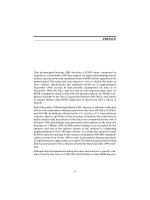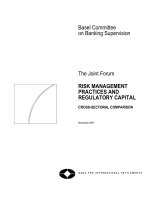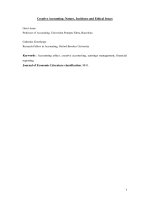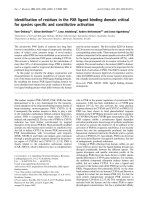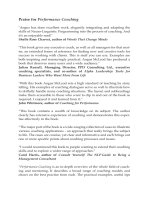Preparing the Army for Stability Operations - Doctrinal and Interagency Issues docx
Bạn đang xem bản rút gọn của tài liệu. Xem và tải ngay bản đầy đủ của tài liệu tại đây (1.21 MB, 277 trang )
This document and trademark(s) contained herein are protected by law as indicated
in a notice appearing later in this work. This electronic representation of RAND
intellectual property is provided for non-commercial use only. Unauthorized
posting of RAND PDFs to a non-RAND Web site is prohibited. RAND PDFs are
protected under copyright law. Permission is required from RAND to reproduce,
or reuse in another form, any of our research documents for commercial use. For
information on reprint and linking permissions, please see RAND Permissions.
Limited Electronic Distribution Rights
Visit RAND at www.rand.org
Explore RAND Arroyo Center
View document details
For More Information
This PDF document was made available
from www.rand.org as a public service of
the RAND Corporation.
6
Jump down to document
THE ARTS
CHILD POLICY
CIVIL JUSTICE
EDUCATION
ENERGY AND ENVIRONMENT
HEALTH AND HEALTH CARE
INTERNATIONAL AFFAIRS
NATIONAL SECURITY
POPULATION AND AGING
PUBLIC SAFETY
SCIENCE AND TECHNOLOGY
SUBSTANCE ABUSE
TERRORISM AND
HOMELAND SECURITY
TRANSPORTATION AND
INFRASTRUCTURE
WORKFORCE AND WORKPLACE
The RAND Corporation is a nonprofit
research organization providing
objective analysis and effective
solutions that address the challenges
facing the public and private sectors
around the world.
Purchase this document
Browse Books & Publications
Make a charitable contribution
Support RAND
This product is part of the RAND Corporation monograph series.
RAND monographs present major research findings that address the
challenges facing the public and private sectors. All RAND mono-
graphs undergo rigorous peer review to ensure high standards for
research quality and objectivity.
Thomas S. Szayna, Derek Eaton, Amy Richardson
Prepared for the United States Army
Approved for public release; distribution unlimited
ARROYO CENTER
Preparing the
Army for Stability
Operations
Doctrinal and Interagency Issues
The RAND Corporation is a nonprofit research organization providing
objective analysis and effective solutions that address the challenges
facing the public and private sectors around the world. RAND’s
publications do not necessarily reflect the opinions of its research clients
and sponsors.
R
®
is a registered trademark.
© Copyright 2007 RAND Corporation
All rights reserved. No part of this book may be reproduced in any
form by any electronic or mechanical means (including photocopying,
recording, or information storage and retrieval) without permission in
writing from RAND.
Published 2007 by the RAND Corporation
1776 Main Street, P.O. Box 2138, Santa Monica, CA 90407-2138
1200 South Hayes Street, Arlington, VA 22202-5050
4570 Fifth Avenue, Suite 600, Pittsburgh, PA 15213-2665
RAND URL:
To order RAND documents or to obtain additional information, contact
Distribution Services: Telephone: (310) 451-7002;
Fax: (310) 451-6915; Email:
Cover photo by Staff Sgt. Antonieta Rico courtesy of U.S. Army
The research described in this report was sponsored by the United States
Army under Contract No. W74V8H-06-C-0001.
Library of Congress Cataloging-in-Publication Data
Szayna, Thomas S., 1960–
Preparing the Army for stability operations : doctrinal and interagency issues /
Thomas Szayna, Derek Eaton, Amy Richardson.
p. cm.
Includes bibliographical references.
ISBN 978-0-8330-4190-6 (pbk. : alk. paper)
1. United States. Army—Civic action. 2. United States—Armed Forces—
Stability operations. 3. Interagency coordination—United States. 4. Military
doctrine—United States. I. Eaton, Derek, 1963– II. Richardson, Amy Frances,
1967– III. Title.
UH723.U54S96 2007
355.02'80973—dc22
2007035982
iii
Preface
is monograph documents the results of a project entitled “Improv-
ing Army Doctrine and Planning for Stability Operations.” e proj-
ect aimed to identify the evolving interagency guidelines and Joint
concepts on stability operations from the perspective of drawing out
potential guidance that may be under development for Army doctrine
on stability operations and to assess the compatibility of ongoing work
on Army doctrine for Joint stability operations.
e monograph should be of interest to those concerned with
stability operations and, more specifically, to military personnel and
civilians interested in the development of greater collaborative inter-
agency capacity for planning and conducting stability and reconstruc-
tion operations. It also should be of interest to the Army and Joint
doctrinal community concerned with stability operations. Information
cutoff date for this document is March 2007.
is research was sponsored by the Office of the Deputy Chief
of Staff, G-3/5/7, Operations and Plans, Headquarters, Department of
the Army, and was conducted within RAND Arroyo Center’s Strategy,
Doctrine, and Resources Program. RAND Arroyo Center, part of the
RAND Corporation, is a federally funded research and development
center sponsored by the United States Army.
e Project Unique Identification Code (PUIC) for the project
that produced this document is DAPRR06013.
iv Preparing the Army for Stability Operations: Doctrinal and Interagency Issues
For more information on RAND Arroyo Center, contact the Director
of Operations (telephone 310-393-0411, extension 6419; fax 310-451-
6952; email ) or visit Arroyo’s Web site at
/>v
Contents
Preface iii
Figures
ix
Tables
xi
Summary
xiii
Acknowledgments
xxiii
Abbreviations
xxv
CHAPTER ONE
Introduction 1
e Context
1
Objectives and Organization
3
CHAPTER TWO
Building Interagency Collaborative Capacity for SSTR Operations 7
Introduction
7
Main Directions in Rethinking of SSTR Operations
7
U.S. Government Draft Planning Framework for Reconstruction,
Stabilization, and Conflict Transformation
13
e Post Conflict Essential Tasks Matrix
16
Interagency Management System for Reconstruction and
Stabilization
18
Military Support to SSTR Operations Joint Operating Concept
23
Other Agencies
25
Actions
27
Issues in Implementing Guidelines for Rethinking SSTR Operations
28
Resources
29
vi Preparing the Army for Stability Operations: Doctrinal and Interagency Issues
Personnel 31
Definition of Agency Roles: Military-Civilian Dimension
33
Definition of Agency Roles: Civilian-Civilian Dimension
35
Scope of Common Action
37
Basic Dilemma
38
Current Stage of Building Interagency Collaborative Capacity for
SSTR Operations
40
Sustaining Interagency Collaboration
52
Conclusions
55
CHAPTER THREE
Army Doctrine in the Context of Interagency SSTR Operations 57
Introduction
57
Our Approach to Translating the ETM
58
ETM Security Sector Tasks Translated into Army Tactical Tasks
63
Establishing a Secure Environment
68
Border Control
70
Civil Protection
74
Personal Security
79
Refugee Security
80
Law and Order
81
Hazard Clearance
85
Peace Operations
88
Host Nation Security Force Development
93
Civil Administration—Security-Related Functions
96
Miscellaneous ETM Essential Tasks
97
Intelligence
97
Other
98
ETM Tasks at Do Not Fit into Existing ART Taxonomy
100
Demobilization, Disarmament, and Reintegration Operations
100
Miscellaneous ETM Essential Tasks with No Appropriate ARTs
102
Gaps in the ETM
106
e Need for Common Definitions
107
Conclusions
110
CHAPTER FOUR
Conclusions and Recommendations 111
Conclusions
111
Recommendations
115
Influencing the Direction of Interagency Collaboration
115
Improving Direct Army Cooperation with Civilians in Operational
Settings
117
Army Doctrinal Revisions
118
Appendix
A.
Field Manuals Referred to in Chapter ree
127
B.
e S/CRS Essential Tasks Matrix
131
C.
Consolidated Essential Tasks Matrix-to-AUTL List
227
Bibliography
241
vii
Contents vii
ix
Figures
3.1. How the ETM Relates to Joint and Army Doctrine 59
3.2.
Essential Tasks Matrix Taxonomy
61
3.3.
e Distribution of ETM Essential Tasks by ART
66
3.4.
Distribution of ARTs: Establishing a Secure Environment
69
B.1.
RAND S/CRS ETM Taxonomy Example
132
xi
Tables
2.1. ETM Goals 17
3.1.
ETM Tasks Included in the ARTs Related to Boundary
Control
71
3.2.
ETM Tasks Included in the ARTs Related to Civil
Protection
75
3.3.
ETM Tasks Included in the ARTs Related to Personal
Security
80
3.4.
ETM Tasks Included in the ARTs Related to Refugee/IDP
Security
81
3.5.
ETM Tasks Included in the ARTs Related to Law and
Order
82
3.6.
ETM Tasks Included in the ARTs Related to Hazard
Clearance
86
3.7.
ETM Tasks Included in the ARTs Related to Peace
Operations
89
3.8.
ETM Tasks Included in the ARTs Related to Conducting
Security Assistance
94
3.9.
ETM Tasks Included in the ARTs Related to Civil
Administration (Security Functions)
96
3.10.
ETM Tasks Included in the ARTs Related to Intelligence
98
3.11.
ETM Tasks Included in Other ARTs
99
3.12.
ETM Tasks Related to DDR Operations
101
3.13.
ETM Tasks at Are Not AUTL-Appropriate Tasks
103
3.14.
ETM Tasks for Which ere Are No Appropriate ARTs
105
3.15.
ETM Tasks at Are Not ARTs
106
xiii
Summary
In 2004–2006, the U.S. government acted to revise the entire way
that the planning and implementation of Stabilization, Security, Tran-
sition, and Reconstruction (SSTR) operations are conducted. e pri-
mary emphasis of the changes is on ensuring a common U.S. strategy
rather than a collection of individual departmental and agency efforts
and on mobilizing and involving all available U.S. government assets
in the effort. e proximate reason for the policy shift stems from the
exposing of gaps in the U.S. ability to administer Afghanistan and
Iraq after the U.S led ousters of the Taliban and Ba’athist regimes.
But the effort to create U.S. government capabilities to conduct SSTR
operations in a more unified and coherent fashion rests on the deeper
conviction that, as part of the U.S. strategy to deal with transnational
terrorist groups, the United States must have the capabilities to increase
the governance capacities of weak states, reduce the drivers of and cat-
alysts to conflict, and assist in peacebuilding at all stages of pre- or
post-conflict transformation. According to the Joint Operating Con-
cept for Military Support to SSTR operations, these operations are
civilian-led and conducted and coordinated with the involvement of all
the available resources of the U.S. government (military and civilian),
nongovernmental organizations (NGOs), and international partners.
Although military assets are an essential component of many SSTR
operations, specific military goals and objectives are only a portion of
the larger SSTR operation.
xiv Preparing the Army for Stability Operations: Doctrinal and Interagency Issues
Building Interagency Collaborative Capacity for SSTR
Operations
In terms of the U.S. organizational-bureaucratic process, the effort to
create a whole new way of thinking about SSTR operations has civilian
and military components. Two founding documents, both signed in
late 2005, gave the process direction. On the civilian and interagency
side, National Security Presidential Directive 44 established a broad
outline of the new approach and gave general guidelines as to the devel-
opment of the interagency process regarding SSTR operations. On the
military side, Department of Defense (DoD) Directive 3000.05 pro-
vided the structure to revamp the whole way that the armed forces
plan, prepare, and execute SSTR operations.
In line with the guidelines of NSPD-44 and DoDD 3000.05, U.S.
federal departments and agencies have launched an effort at implemen-
tation and compliance. We have observed a massive effort throughout
the federal government to adjust to NSPD-44, although we also have
observed that the Departments of State and Defense are most affected
by the new guidelines and also most involved in the effort. e depth
of the efforts and commitment to the NSPD-44 process differs among
the other agencies and departments, although it is our observation that,
at this stage, it generally remains at a superficial level. As mandated,
the Office of the Coordinator for Reconstruction and Stabilization
(S/CRS) is leading the interagency effort in planning for SSTR opera-
tions. We identified four basic pillars of the process of rethinking of
SSTR operations at the interagency level from the perspective of impli-
cations for the Army and its development of SSTR capabilities.
e U.S. Government Draft Planning Framework for Reconstruc-
tion, Stabilization, and Conflict Transformation, Version 1.0, issued by
the U.S. Joint Forces Command J-7 and the Office of the Coordinator
for Reconstruction and Stabilization, Department of State (December
2005), allows for direct input by Army planners during the develop-
ment of strategic planning for an SSTR operation and in translating
these strategic plans into individual agency implementation plans at the
task and activity levels. Especially in implementation planning, Army
personnel may be engaged in a central fashion. To function effectively
Summary xv
in such contexts, Army personnel engaged in such processes will need
to have good knowledge of relevant expertise in other agencies, the
ability to work with such personnel, and a common language. is is
essential, as the Draft Planning Framework stipulates a clear and broad
role for ground forces in supporting SSTR operations.
e Post Conflict Reconstruction Essential Tasks Matrix (ETM),
issued by the Office of the Coordinator for Reconstruction and Sta-
bilization, Department of State (April 2005), is a compilation of indi-
vidual tasks that, taken as a whole, are intended to support a country
in transition from armed conflict or civil strife to sustainable stability.
e value of the ETM is in imposing a common language and for
choosing a set of missions that may then lead to the selection of appro-
priate agencies to implement the tasks. e ETM amounts to a list
of tasks that conceivably may constitute an SSTR operation; some of
these tasks may be assigned to Army forces engaged in support of the
SSTR operation. Because the ETM provides a common interagency
lexicon for developing missions, coming up with metrics, and defin-
ing outcomes, the list is of primary importance to the Army and thus
it needs to be harmonized with Army doctrine and training. Much of
our effort was devoted to this task (discussed below) by way of exam-
ining current and developing U.S. Army doctrine to explore whether
and to what extent doctrinal gaps exist between the ETM and evolv-
ing Army doctrine on stability operations and to identify the potential
doctrinal solutions to close the gaps.
e Interagency Management System (IMS) for Reconstruc-
tion and Stabilization, or the operational concepts, developed by
the National Security Council and S/CRS, center on three types of
civilian-military teams that would ensure a unity of effort of an SSTR
operation. Together, these teams are designed to integrate civilians and
the military during the planning and execution of conflict preven-
tion, major combat operations, and post-conflict stability operations at
the level of the Policy Coordinating Committee down to the tactical
level. At the strategic-national level, the main steering group will be
the Country Reconstruction and Stabilization Group (CRSG). At the
strategic-theater level, the coordination group will be the Integration
Planning Cell (IPC). Advance Civilian Teams (ACTs) will operate at
xvi Preparing the Army for Stability Operations: Doctrinal and Interagency Issues
the operational and tactical levels. e three-team concept provides
a strategic-to-tactical-level planning and coordination mechanism for
SSTR operations. e IPC and ACTs will work directly with military
personnel in planning and executing SSTR operations. e IPC espe-
cially may have a major role in military planning, as the team is tasked
with ensuring that post-conflict reconstruction and stability objectives
are taken into account during the planning for major combat opera-
tions. With its direct channel to the CRSG and the highest decision-
making authorities, the IPC would have the means to effect change
in combatant command (COCOM) plans. If the concept is imple-
mented, Army personnel would have to work closely with IPC staff to
ensure that the civilian staff understand the capabilities of Army units.
Implementation of the concept also means that there would be a clear
and close connection between ACTs and Army forces deployed for
an SSTR operation. Besides acting as a “super-Provincial Reconstruc-
tion Team” in terms of the effect on transition and reconstruction, the
ACTs would provide a venue for direct interaction and coordination
between civilian-led efforts and military support to an SSTR opera-
tion. Since the ETM would be the common language describing tasks
in an SSTR operation, Army forces will have to be fully conversant in
the ETM terminology and aware of the planning structure (three-team
concept) in an SSTR operation.
e Military Support to Stabilization, Security, Transition, and
Reconstruction Operations Joint Operating Concept (JOC), Version 2.0,
U.S. Joint Forces Command, J-9 (August 2006) outlines the long-term
concept of the military role in future SSTR operations. ere is a broad
scope to the JOC, in that it covers military roles in such actions as
assisting fragile or failing states, assisting states facing modest inter-
nal challenges, administering occupied territory in the aftermath of
forceful regime change, and helping stable governments face the con-
sequences of a natural disaster. Although many of the details in the
JOC are bound to be revised, its overall outlines are common with the
S/CRS-sanctioned pillars and likely to remain in place and eventu-
ally be binding for the Army. In that sense, the JOC is important in
expressing the Joint vision of SSTR operations and providing the basis
for the Army’s future years force development process.
Summary xvii
All of the above notwithstanding, the effort to redefine the U.S.
approach to SSTR operations is still in its early stage of development;
it is not a given by any means that the objectives outlined in NSPD-44
will come about, and basic problems associated with the startup of a
fundamental change across U.S. government departments and agencies
remain. We see the following issues as most important: availability of
resources, appropriate personnel, definition of agency roles, and scope
of common action. We note that most of these issues are recognized
by the main stakeholders, although that recognition by itself does not
necessarily mean that the issues are easily resolved or that a unity of
views exists on how to resolve them.
From an organizational perspective, the stakeholder most inter-
ested in seeing the successful implementation of NSPD-44 and the
evolution of S/CRS into a strong interagency coordinating body is the
DoD. Within the DoD, the land forces (the Army and the Marine
Corps) have the greatest interest in seeing S/CRS succeed, since the
land forces, in particular the Army, are the main providers of the mili-
tary capabilities required in SSTR operations. is stems from the fact
that stability operations are labor-intensive and land-power-focused.
Bringing in the capabilities of the civilian departments and agencies
to carry out tasks in SSTR operations would reduce the demands on
the Army. But the flip side of the preceding is that the Army is also in
the position of having to prepare to step in should S/CRS not be able
to meet some of its obligations and the process envisioned in NSPD-
44 falls short of its goals. ere is no choice in the matter because, as
DoDD 3000.05 recognizes explicitly, SSTR operations may impose
broad demands on the United States and the DoD will step up to meet
them.
is leads to a basic dilemma for the DoD and the Army. If
the DoD, and primarily the Army, continues to develop the capabili-
ties to implement U.S. goals in SSTR operations, then the incentives
are reduced for the civilian departments and agencies to participate
in making their expertise and personnel available for potential SSTR
operations, and the need for an office such as S/CRS may become less
clear because the capability may be seen as redundant. Planning for
the case where S/CRS plays a weak coordinating role may make this
xviii Preparing the Army for Stability Operations: Doctrinal and Interagency Issues
all the more likely, despite the DoD’s clear preference for this not to
occur. However, assuming that NSPD-44 will be implemented fully is
untenable, as appropriate capabilities by the armed forces may be lack-
ing. Put more succinctly, the Army and the DoD are in the position of
simultaneously trying to move forward the interagency process envi-
sioned in NSPD-44 and planning to provide all the needed capabilities
if the process fails to accomplish its stated objectives. Finally, although
the Army has a great stake in the success of the process outlined in
NSPD-44, it has limited leverage in influencing the overall interagency
process. Put in terms of what is at stake, it is not yet a given that a last-
ing change toward an interagency approach to SSTR operations, as
outlined in NSPD-44, will take place. e Army as an institution has
some influence on the process, but ultimately this is a government-wide
change that needs to happen.
We use a template, developed by the Government Accountability
Office (GAO), of key practices crucial in assisting and sustaining col-
laborative efforts among government agencies to assess the extent of
progress so far in building collaborative interagency capacity for SSTR
operations and we then recommend how the Army can advance the
interagency process. We find that basic elements that would encour-
age the success of the NSPD-44 process are not yet in place. Specifi-
cally, the initial four “key practices” have still not been developed suf-
ficiently. ese key practices are (1) define and articulate a common
outcome, (2) establish mutually reinforcing or Joint strategies, (3) iden-
tify and address needs by leveraging resources, and (4) agree on roles
and responsibilities.
Army Doctrine in the Context of Interagency SSTR
Operations
Since the ETM articulates the potential interagency tasks to be accom-
plished during an SSTR operation, it is essential that the Army be
doctrinally prepared to support the ETM. We examined the extent to
which current and emerging U.S. Army doctrine supports the essential
tasks identified by the ETM as being required to establish a safe and
Summary xix
secure environment during SSTR operations (one of five S/CRS ETM
technical sectors).
1
We focused on the security mission because it is
the one that U.S. ground forces, primarily the Army and the Marine
Corps, are uniquely capable of conducting and they are bound to have
a lead role in the mission. “Translating” the essential tasks in the ETM
security technical sector into Army Tactical Tasks (ARTs) and aligning
the ETM essential tasks with existing ARTs allowed us to identify key
insights regarding existing and emerging SSTR operations doctrine,
pointed out the potential gaps in Army doctrine relating to SSTR
operations, and led us to propose doctrinal solutions.
We identified three main insights. First, although the new FMI
3-07 is a step forward in terms of integrating many SSTR operations
concepts into emerging Army doctrine, past experience suggests that it
is important to ensure that supporting doctrine and tactics, techniques,
and procedures (TTPs) are developed as needed to provide the practi-
cal foundation for higher-level doctrinal concepts. Second, although
critical ETM task areas are beginning to be addressed in emerging
doctrine (as we currently understand it), there remain several areas that
are insufficiently supported by emerging doctrine. ese areas include
the key tasks of civil protection, border control, the provision of law
and order to host nation populations, and the development of host
nation security forces. In addition, essential concepts, such as civil
security, need to be developed further and broadly incorporated into
Army doctrine. Finally, the Army Universal Task List (AUTL) hier-
archy and associated ART definitions need to be adjusted to account
for the formal elevation of SSTR operations to be a coequal of major
combat operations.
Modifying Army doctrine in line with the ETM and prepar-
ing Army personnel for dealing with the proposed civilian teams will
improve interagency effectiveness in potential future SSTR operations
as well as give the Army greater input in the interagency process. Doc-
trinal change is essential, as it will drive changes in training and the
1
e five technical sectors are (1) security, (2) governance and participation, (3) humani-
tarian assistance and social well-being, (4) economic stabilization and infrastructure, and (5)
justice and reconciliation.
xx Preparing the Army for Stability Operations: Doctrinal and Interagency Issues
other dimensions of doctrine, organization, training, materiel, leader-
ship and education, personnel, and facilities (DOTMLPF).
Recommendations
U.S. participation in SSTR operations will remain a persistent feature
of U.S. defense policy. Whatever the term used to describe these types
of operations, the United States, throughout its history, has used its
power in a way currently referred to as SSTR operations, and these
operations can determine the success or failure of the larger U.S. objec-
tives in the conflict. In this context, developing greater interagency
capacity for SSTR operations is an overall goal that will retain reso-
nance, regardless of the specific and frequently shifting bureaucratic-
organizational responsibilities related to SSTR operations. Currently,
there is an opportunity for the Army to deepen the collaborative inter-
agency capacity for SSTR operations, although the window of oppor-
tunity may be closing, as we note there is creeping “SSTR fatigue.”
Our recommendations fall into three categories. One, in terms of
influencing the direction of interagency collaboration, the Army can
act as a catalyst in working out the strategic vision, the roles of specific
agencies, and the integration of the capabilities of various agencies in
planning and executing SSTR operations. e Army also can use its
expertise in detailed planning and familiarity with SSTR operations
to assist S/CRS in working out a plan of action, ensure coordination,
develop metrics, and provide periodic assessments of progress in build-
ing collaborative capacity for SSTR operations. e Army’s educational
and research institutes can play a major role in the process.
Two, in terms of improving direct Army cooperation with civil-
ians in operational settings, the Army can draw on its experience with
Provincial Reconstruction Teams (PRTs) in Afghanistan and simi-
lar teams in the Balkans to contribute to design of a template for the
ACTs. is might take the form of identifying the standard elements
of a PRT, the additional assets that may be required depending on the
demographic and economic characteristics of the province, and a meth-
odology for determining the appropriate skill sets and capabilities that
Summary xxi
might be required. e above applies especially to ACTs, but identify-
ing the skill sets required also would drive the composition of the IPC
and the CRSG. In addition, the Army can take the lead in developing
concepts and standard terminology that would be binding for inter-
agency actors in SSTR operations. U.S. Army Training and Doctrine
Command (TRADOC) (especially the Army Capabilities Integration
Center [ARCIC]) and the Peacekeeping and Stability Operations Insti-
tute (PKSOI) (relying on resources at the Center for Army Lessons
Learned (CALL)) can play a major role in these endeavors.
Finally, there is a multitude of specific recommendations that the
Army needs to consider when it comes to revising its doctrine on SSTR
operations and, conversely, in ensuring that the ETM adequately rep-
resents the tasks that may be required in SSTR operations. Among
the most important, the Army needs to consider developing appro-
priate supporting doctrine and TTPs to ensure that the emerging
SSTR-related concepts are successfully executed and internalized by
the Army’s operational forces. We propose 48 specific steps (listed in
Chapter Four) that the Army can take to achieve greater compatibility
of its doctrine with the emerging interagency thinking on tasks in the
security sector of SSTR operations.
xxiii
Acknowledgments
e authors are grateful to LTG James J. Lovelace, Jr., the U.S. Army
Deputy Chief of Staff, Operations and Plans, for sponsoring the
research. We are also grateful to COL Daniel Klippstein, LTC Angel
Perez, COL Simon Wolsey, LTC James Boozell, and Mr. Max Alston,
all at Headquarters, Department of the Army, G-3/5/7, for monitoring
the progress of the study.
Many people in the Department of State, the Department of
Defense, the Joint Forces Command, and the Department of the Army
deserve thanks for their time and cooperation with project staff.
e individuals listed below were especially helpful in the course
of the research: at the Department of State, COL William Lee, Senior
Military Advisor, Office of the Coordinator for Reconstruction and
Stabilization (S/CRS); at the Office of the Deputy Assistant Secretary
of Defense for Stability Operations, LTC Richard Lacquement and
Ms. Heather Panitz; at the U.S. Joint Forces Command, Mr. Francis
Gibbons, Mr. Steve Weir, LTC Stuart Pollack, LtCol Sam Price, and
Mr. Phil Kearley; at the Institute for Defense Analyses (IDA), Martin
Lidy was exceptionally helpful to the project staff.
e authors are especially grateful to the individuals listed below
from the Department of the Army: at the U.S. Army Combined Arms
Center, Combined Arms Doctrine Division, Mr. Clinton Ancker,
LTC Jeffrey LaFace, LTC Richard Paz, LTC Bruce Foreman, LTC
Jan Horvath, MAJ Steven Leonard, MAJ omas Westen, and Mr.
Maurice Pelletier; at the U.S. Army Maneuver and Support Center
(MANSCEN), Futures Center, Mr. Robert Abernathy and Mr. Arnold
Jensen; at the U.S. Army Military Police School, Doctrine Division,




